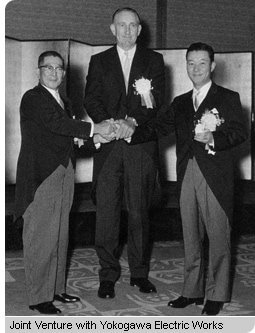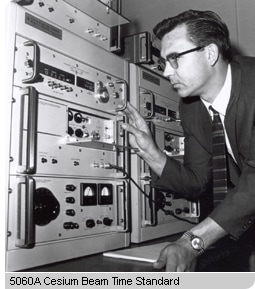Company History Timeline — 1960s
The test and measurement field continues its steady growth. The company branches out into related fields such as medical electronics and analytical instrumentation, and begins to be noticed as a progressive, well-managed company and a great place to work. This decade also sees the introduction of several innovative products including the Cesium Beam “Atomic” Clock and the first product to provide the company with over 1 million dollars per month, the 8551 Spectrum Analyzer.
1960
- New oscilloscope design is the first to use a new sampling technique to view the faster digital waveforms used in computer technology.
- Company establishes first U.S. manufacturing plant outside of Palo Alto in Loveland, Colorado.
1961
- Company enters medical field with purchase of Sanborn Company, Waltham, Massachusetts.
- Lists on New York Stock Exchange.
1962
- HP's first listing on Fortune magazine’s list of the top 500 U.S. companies: No. 460.
1963
- First joint venture is formed (with Yokogawa Electric Works): Yokogawa Hewlett-Packard in Tokyo, Japan.
- First synthesizer to generate electrical signal at a precise frequency desired becomes a major contribution to automated testing.

1964
- Company celebrates 25th anniversary.
- Dave Packard elected chairman; Bill Hewlett elected president.
- Highly accurate HP 5060A cesium-beam time standard is introduced.
- Microwave spectrum analyzer is the first to make direct
reading, calibrated analysis of individual signals within
a frequency band.
1965
- HP enters the analytical instrumentation field with the acquisition of F&M Scientific Corporation, Avondale, Pennsylvania.
- Net Revenue: $165 million; Employees: 9,000.
1966
- HP Laboratories is formed, which would eventually become Agilent Labs. The company’s central research facility is one of the world’s leading electronics industry research centers.
- HP 2116A, the company’s first computer, is designed as a controller for test and measurement instruments.
- First all-solid-state component oscillator is introduced. Its small size, light weight and large screen make it easy to use in lab, field or production work.
- Company develops breakthrough GaAsP (gallium-arsenide-phosphide) light-emitting diodes (LEDs), which would prove useful in many applications, including alphanumeric displays for handheld devices and, eventually, stoplights and signage.
1967
- Boeblingen facility introduces a non-invasive fetal heart monitor that detects fetal distress during labor.
- Boeblingen plant also pioneers the concept of flexible working hours, an idea adopted at HP and Agilent manufacturing facilities around the world.
- Company engineers fly to 18 countries, with the atomic clocks they have developed, to synchronize international time standards. Eventually, the cesium-beam standard becomes the standard for international time.
1969
- Dave Packard appointed U.S. Deputy Secretary of Defense (serves from 1969-71).
- First robotic sample injector for chromatography allows samples to be analyzed while system is unattended.